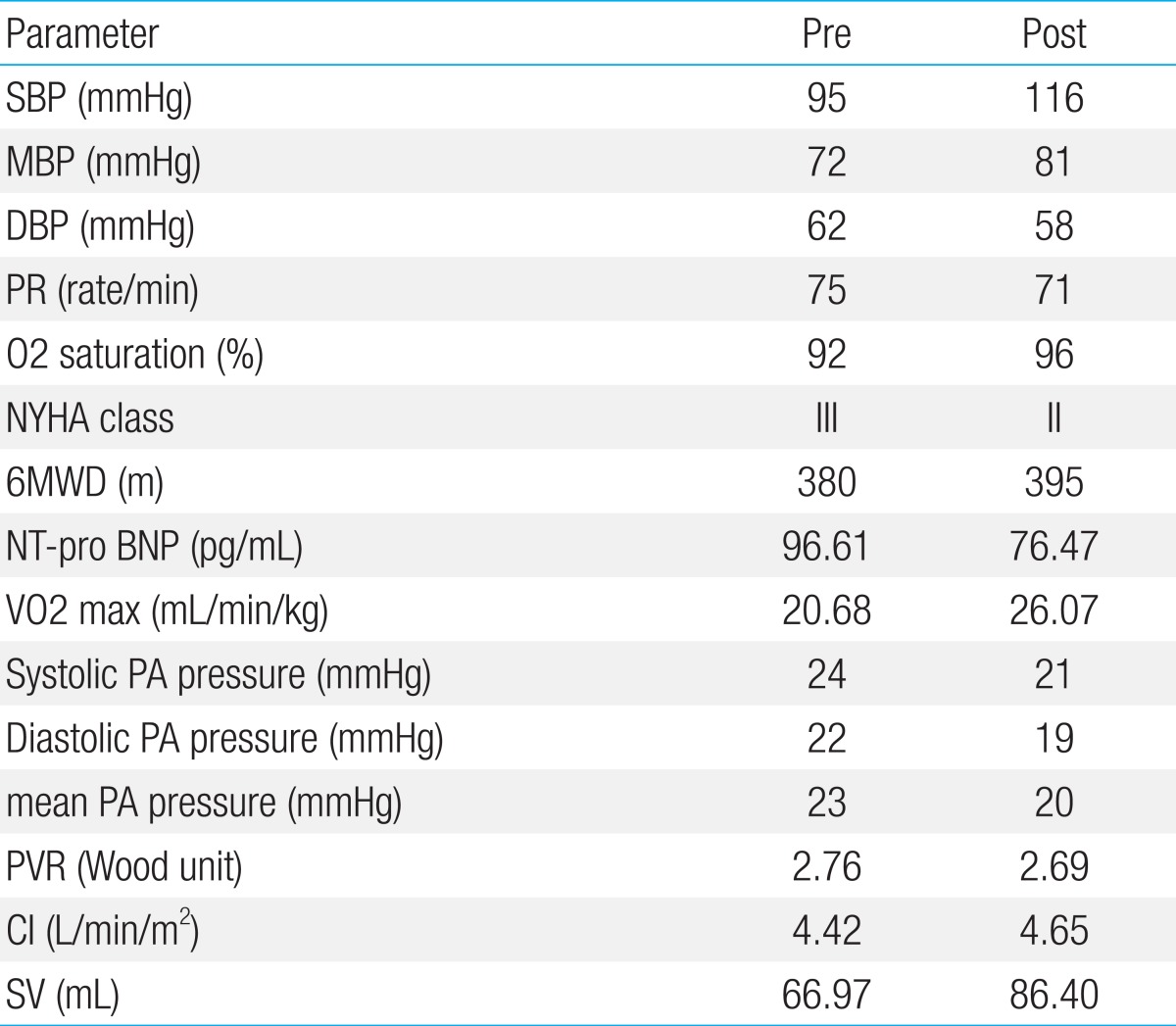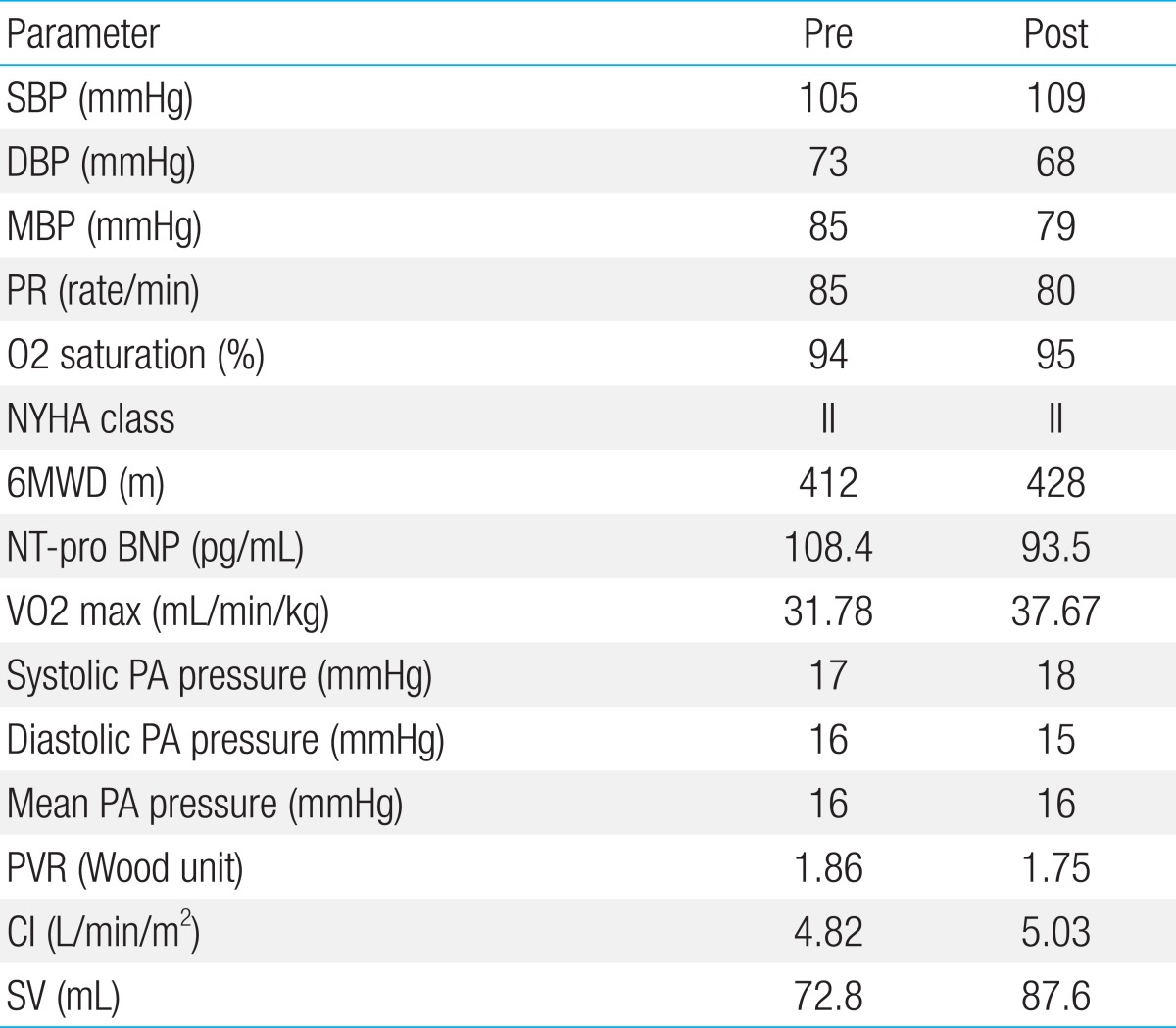Inhaled iloprost for the treatment of patient with Fontan circulation
Article information
Abstract
Decreased exercise capacity after Fontan surgery is relatively common and the failure of the Fontan state gradually increases with age. However, there is no further treatment for patients with Fontan circulation. Pulmonary vasodilation therapy is an effective method to solve this problem because pulmonary vascular resistance is a major factor of the Fontan problem. Inhaled iloprost is a chemically stable prostacyclin analogue and a potent pulmonary vasodilator. We experienced two cases of Fontan patients treated with inhaled iloprost for 12 weeks. The first patient was an 18-year-old female with pulmonary atresia with an intact ventricular septum, and the second patient was a 22-year-old male with a double outlet right ventricle. Fifteen years have passed since both patients received Fontan surgery. While the pulmonary pressure was not decreased significantly, improved exercise capacity and cardiac output were observed without any major side effects in both patients. The iloprost inhalation therapy was well tolerated and effective for the symptomatic treatment of Fontan patients.
Introduction
Since the first Fontan procedure was introduced by Fontan in 1971, the surgical technique has evolved and the survival rate has shown dramatic improvement. Recently, Fontan surgery has been performed as an operation of the final stage for congenital heart disease with single ventricle physiology1).
In Fontan circulation the systemic venous pressure is the driving force of pulmonary circulation. Therefore, the pulmonary vascular resistance (PVR) must be lower than the antegrade transpulmonary flow resistance2). Thus, even a mild increase in the PVR may interfere with pulmonary circulation which in turn may result in decreased preload of ventricle, diminished cardiac output, and declined exercise tolerance3,4).
Loss of pulsatility of pulmonary flow, reduced growth of the pulmonary vasculature, micro and macro thromboembolism in pulmonary circulation and reduced ventricular function are underlying mechanisms that induce the high PVR in Fontan circulation5,6,7).
Several studies8,9,10,11,12) reported the pulmonary vasodilating therapy had an effective influence on Fontan patients so we want to determine whether inhaled iloprost as a pulmonary vasodilator might have a role in the clinical symptoms, hemodynamics and exercise capacity of Fontan patients.
Ethical approval for this study and permission for acquiring, analyzing and reporting of patient's data were obtained in accordance with the guidelines of the Institutional Review Board of Gachon University Gil Medical Center (No. GIRBA 2476).
Case reports
1. Case 1
An 18-year-old female with pulmonary atresia with intact ventricular septum status post Fontan surgery at age of three years complained of aggravated dyspnea on exertion (DOE). A physical examination showed regular heart beat without murmur and mild pitting edema on the pretibial area, liver and spleen were not palpable. Recently, she felt more difficult to climb the stairs due to shortness of breath. New York Heart Association (NYHA) class was III. She had been taking the digoxin, enalapril, and aspirin. The inhaled iloprost was administered at 60 microgram/day divided by six times for 12 weeks. Pre and post medication, laboratory test-including pro brain natriuretic peptide, cardiac catheterization, bicycle ergometer test, NYHA class, and 6-minute walking test-were performed. The DOE was improved about 4 weeks after the medication. After 12 weeks, the patient's systemic blood pressure and O2 saturation were increased. Six-minute walking distance was increased from 380 to 395 m and NYHA class changed from III to II. Maximal oxygen consumption was increased. In cardiac catheterization, the cardiac index and stroke volume were increased without significant change of pulmonary pressure and PVR. The results are shown in Table 1.
2. Case 2
A 22-year-old male with double outlet right ventricle status post Fontan surgery at age of five years complained of mild DOE only. Physical examination showed no specific findings. NYHA class was II. He volunteered for an attempt. He had been taking the enalapril and asprin. He also received the same medication (inhaled iloprost) and underwent several tests. After 12 weeks, the patient's systemic blood pressure, O2 saturation, and NYHA class were not changed significantly. N-terminal pro brain natriuretic peptide was decreased. The maximal oxygen consumption was increased. In cardiac catheterization, the cardiac index and stroke volume were also increased without significant change of pulmonary pressure and PVR. The results are shown in Table 2.
Discussion
Despite the increased survival rate of patients who has congenital heart disease with single ventricular physiology due to advanced surgical technique, the Fontan surgery is still a palliative procedure. Development of the Fontan failure state might occur gradually over time; ventricular dysfunction, aggravated cyanosis, hepatic dysfunction, coagulopathy, protein loosing enteropathy, plastic bronchitis, arrhythmia etc.1). Progressive decreasing cardiac output, and increasing central venous pressure can be also observed in Fontan physiology with age1).
Most patients who underwent cardiac transplant long after Fontan surgery had elevated PVR before and immediately after the operation13). Indeed, PVR is an important factor in the progressive decline in efficiency of the Fontan physiology. The loss of pulsatile blood flow of pulmonary circulation of Fontan patients is positively correlated with high PVR. The lowering of PVR may increase pulmonary blood flow and preload reserve in Fontan physiology, and for this reason the selective pulmonary vasodilating therapy is interesting as a means to improve the Fontan circulation8). In addition, nonpulsatile pulmonary blood flow may reduce capillary recruitment and endothelial function. As a result of endothelial dysfunction, impairment in production of nitric oxide, prostacyclin and prolonged overexpression of endothelin-1 level can be observed5,14).
Several authors have reported on the effects of Bosentan on Fontan patients8,9,10). Most studies were based on high level of endothelin-1 in Fontan patients9,10), the endothelin receptor antagonist induced improvement of clinical, hemodynamic parameters and exercise capacity. Experiences with sildenafil therapy on Fontan patients have also been reported11,12). In a recent study, Rhodes et al.15) reported on the effect of inhaled iloprost on exercise function of Fontan patients. In this article the authors administered a single treatment with iloprost nebulizer just before exercise and concluded that iloprost improves the peak oxygen pulse and peak VO2 of patients with Fontan physiology.
In our two case studies, we found that 12 weeks of iloprost therapy showed an association with improvement of clinical, hemodynamic parameters and exercise capacity in patients with Fontan physiology. First case was considered Fontan failure because of aggravated DOE, functional class and pitting edema. The other case was voluntary. Unlike previous study using iloprost once, we used iloprost for three month period and positive results were achieved without major side effects. In addition, we found that iloprost was effective for Fontan patients with or without symptoms.
Although more advanced curable treatments of Fontan physiology have not been developed, pulmonary vasodilator therapy on Fontan circulation is one of good suggestion for symptomatic treatment of Fontan failure and improvement of the cardiac output. Conduct of further studies including a larger number of patients is necessary.
Notes
No potential conflict of interest relevant to this article was reported.

